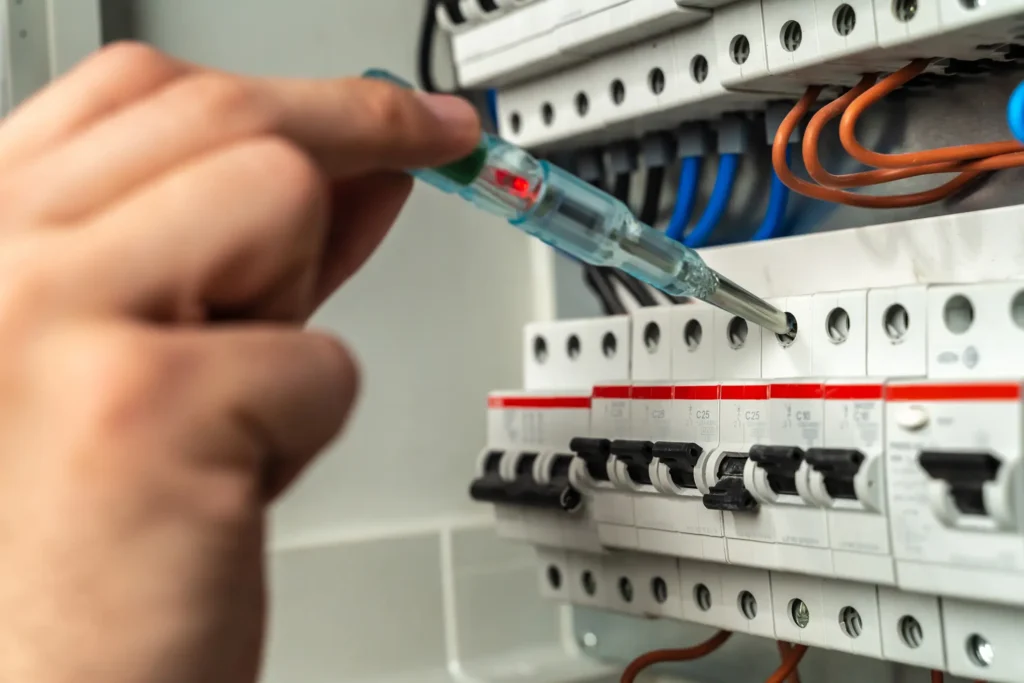There you are, calmly going about your day when – bam! – the lights go out and half your home’s appliances suddenly quit working. You head to the circuit breaker panel hoping for an easy fix, but no matter how many times you flip that stubborn breaker, it won’t stay reset. Uh oh, looks like you’ve got a circuit throwing a temper tantrum.
Few household headaches are more maddening than wrestling with a circuit breaker that simply refuses to cooperate. Your home’s electrical system is basically holding your comfort and conveniences hostage until you can get that tripped breaker situation under control. No TV, no working outlets, and the threat of a deep freezer’s worth of thawing food – it’s a potential domestic disaster!
Before you start frantically Googling for an electrician, let’s go over some troubleshooting steps to try resolving the issue yourself. From overloaded circuits to electrical shorts and other wiring woes, there are actually several potential culprits that could be causing your breaker’s bout of defiance. With some basic investigation and know-how, you may just be able to get those circuits playing nice again without professional backup.

Common Causes of Circuit Breakers Not Resetting
Alright, let’s get into some of the usual suspects that could be behind your breaker’s refusal to cooperate. As with most electrical system snafus, there are a few main culprits that tend to be the circuit interrupters.
The Overloaded Circuit
This is probably the most common reason for breakers to get their wires in a bunch. Basically, you’ve got too many energy-hungry appliances and devices all trying to run on the same circuit at once. The breaker detects electrical overload and cuts power before things have a chance to really heat up (literally).
Maybe you plugged in one too many space heaters during the winter months. Or you were running the AC, laundry machines, TV and every other power-zapping appliance simultaneously. The circuit just couldn’t keep up with that amount of demand so it freaked out and tripped to prevent potential fire hazards.
The Electrical Short
Another likely culprit is an actual physical short circuit somewhere in your home’s wiring system. This happens when an active hot wire comes into direct contact with a neutral one, causing a massive electrical surge. Outdated aluminum wiring, damage from renovations, or faulty appliances can all create these dangerous short circuits.
When your circuit breaker senses that sudden power overload, it has no choice but to shut off the entire circuit to protect against potential electrical fires or damage. Until you can locate and repair that short, the breaker won’t allow the flow of electricity to resume.
The Ground Fault Interruption
You know those GFCI outlets with the little reset buttons, usually found in bathrooms, kitchens and other water risk areas? They’re designed to cut power anytime an electrical ground fault is detected, like when a live wire comes into contact with water or moisture.
Well, your circuit breakers essentially work the same way on a larger scale. If one senses a dangerous ground fault anywhere on its circuit, it’s going to trip and cut power to prevent shocks or electrocution hazards. Faulty appliances, damaged wiring, and other electrical issues can all trigger these ground fault breaker trips.
The GFCI/AFCI Factor
Speaking of those GFCI outlets, some circuit breakers actually come with built-in ground fault and arc fault protection as well. If the breaker itself has a GFCI or AFCI component that detects a hazardous ground fault or electrical arcing situation, it’s designed to cut power to that entire circuit immediately.
While incredibly useful safety features, it also means one minor arc fault or grounding issue could be the reason that stubborn breaker won’t reset. You’ll need to locate and resolve the underlying problem before it will allow that flow of electricity to resume.
As you can see, there’s no shortage of potential culprits that could be causing your breaker to flip out! From overloaded circuits to dangerous short circuits and electrical faults, a lot can throw a wrench into your home’s electrical system. Knowing the likely causes can at least help narrow down some basic troubleshooting steps.
Troubleshooting Steps
Okay, now that we’ve covered some of the usual suspects behind breaker tantrums, it’s time to get into the hands-on troubleshooting tactics. A few basic checks and procedures could be all it takes to get that stubborn circuit cooperating again without professional backup. Let’s run through the DIY steps!
Step 1: Identify the Tripped Breaker
First things first, you’ll need to locate the circuit breaker panel for your home. It’s that big metal box filled with all the individual breaker switches, usually in a basement, garage or utility room area. Once you’ve got eyes on the panel, start scanning for any breakers that are currently in the “tripped” or “off” position while the others remain on.
Pro Tip: If you can’t easily tell which breaker is the culprit, start killing power to the main breakers one by one until you notice which set of lights, outlets or appliances cuts off. That’ll reveal the tripped circuit!
Step 2: Unplug Appliances and Devices
Assuming it’s just an overloaded circuit causing the breaker to trip, you’ll want to start eliminating some of those power-hungry loads. Go around and unplug anything non-essential that was running on the tripped circuit like window AC units, space heaters, power tools, electronics, etc. Reducing the electrical demand should (hopefully) allow the breaker to reset properly.
Step 3: Reset the Circuit Breaker
With excess loads removed, you can now attempt to reset that stubborn breaker. But don’t just flip it on and off quickly! There’s an actual technique to this:
- Fully flip the breaker to the “off” position and let it cool for a minute
- Then, with firm and smooth pressure, re-set it back to the “on” position
You may hear it click into place, or feel it catch slightly when resetting. If it stays in the “on” position without tripping again right away, you’re in business! Allow a few minutes for the electrical flow to resume before plugging stuff back in one-by-one.
Step 4: Check for Underlying Issues
Of course, if the breaker just keeps re-tripping even after removing excess loads, there could be a more serious underlying issue at play. Time for some visual inspection! Grab a flashlight and follow the paths of any circuits that keep tripping. Look for potential damage like exposed, charred or gnawed wiring, moisture intrusion, or any obvious short circuit situations.
You’ll also want to check for faulty appliances or electronics that could be causing a ground fault or arcing problem. Unplug anything suspicious that may have been running on the circuit when it tripped. Replacing or repairing those faulty items could be the key to getting that breaker reset.
Step 5: Call an Electrician
Let’s be honest – if you’ve made it through all those basic troubleshooting steps and the breaker still won’t cooperate, it’s probably time to call in professional backup. Persistent tripping issues could indicate more complex electrical system problems like deteriorating wiring, main service overloads, or other safety hazards that require an expert set of eyes.
Don’t feel bad about waving the white flag! Electrical systems can get complicated fast, and you don’t want to risk potential shocks, fires or further damage by going rogue. A qualified electrician will have the specialized tools, training and troubleshooting experience to properly diagnose and repair the underlying circuit issue.
The Nuclear Option
Okay, let’s say you’ve tried every basic trick in the book and that pesky breaker just won’t stay reset no matter what. As a very last-ditch, temporary workaround, you may need to take the nuclear option: kill the entire circuit.
Carefully switch that problem breaker into the “off” position and just leave it there until you can get an electrician out to inspect things. Yes, it’ll knock out power to that entire set of outlets, lights and appliances – but it at least prevents that breaker from tripping again and again in a constant headache loop. Just be sure to unplug or turn off anything important on that circuit to prevent damage while it’s dead.
This is obviously a major inconvenience, but sometimes it’s the only way to keep that breaker from driving you up a wall until the pros can come set things right. Don’t try using that circuit with the breaker off though – that’s just begging for electrical fires or damage! Safety first, even if it means roughing it without power in part of your home for a little while.
The Backup Plan
At the end of the day, a little DIY know-how goes a long way when it comes to dealing with tripped circuit breakers. But eventually, most homeowners are going to need to call in reinforcements from a qualified electrician. Persistent breaker issues could indicate more serious electrical system hazards that are best left to the professionals.
So don’t be afraid to wave the white flag if your basic troubleshooting efforts can’t get that stubborn breaker to cooperate! Backup is just a phone call away to get your home’s circuits operating safely and reliably again. A little professional repair now can save you a huge headache down the road.
Preventive Measures
Dealing with a tripped circuit breaker is never a fun experience, so taking some proactive steps to prevent those electrical tantrums can save you a huge headache down the road. A little preventive maintenance goes a long way when it comes to keeping your home’s circuits operating safely and reliably.
Avoid Overloading Circuits
Since overloaded circuits are one of the most common culprits behind breaker trips, it’s important to keep an eye on how much electrical demand you’re putting on each circuit. Distribute power-hungry appliances and devices across multiple circuits rather than clustering them all on just one or two.
Also, be smart about using extension cords and power strips – don’t just plug a bunch of high-wattage items into the same outlet! That’s a surefire way to overload a circuit. Use surge protectors and distribute electrical loads sensibly.
Perform Regular Inspections
Every so often, it’s a good idea to do a hands-on inspection of your home’s electrical system and appliances. Look for any signs of damage like frayed wiring, loose connections, or sketchy-looking electronics that could create potential short circuit or ground fault hazards. Nip those issues in the bud before they have a chance to cause breaker trips!
While you’re at it, go ahead and blow out any dust bunnies or gunk buildup around outlets, circuit breakers and appliances. That excess debris can potentially interfere with electrical flow and cause operational issues over time.
Consider Upgrading Electrical Panels
If your home is rocking a pretty outdated or low-capacity electrical panel and breaker system, it may just be due for an upgrade. Older panels can become overburdened as our modern households consume more and more electricity for all our devices and appliances. That consistent overload is just begging for breaker trips and other electrical woes.
Replacing your panel with a new model that has more circuits and higher amperage capacity could be the cure for constant breaker issues. It’s an investment for sure, but one that provides much-needed electrical capacity while also bringing your system up to current safety standards.
The Bottom Line
Look, no one likes dealing with breakers that just won’t cooperate no matter how many times you reset them. It’s a huge inconvenience that disrupts your entire routine and comfort at home. But by taking some preventive measures and not overtaxing your electrical system, you can hopefully avoid a lot of those circuit breaker headaches.
At the very least, keeping up with maintenance and being smart about electrical usage buys you more time between breaker trips. And if upgrades are needed, pulling the trigger sooner rather than later prevents minor issues from spiraling into much bigger (and more expensive) problems down the road. A little proactive effort saves you tons of reactive headaches!
The Shocking Truth About Circuit Breakers
At the end of the day, having a properly functioning electrical system is one of those must-haves for a comfortable, safe home. When the circuit breakers start throwing temper tantrums and refuse to reset, it’s incredibly disruptive and stressful. Suddenly you’re left stumbling around in the dark, wondering if the deep freeze is slowly turning into a food poisoning hazard.
Fortunately, with the troubleshooting tips and preventive measures covered here, you’ve got a fighting chance at resolving minor breaker issues through some basic DIY efforts. But if that stubborn circuit just won’t cooperate no matter what you try, don’t be a hero – call in the professionals.
The experienced electricians at Gene Johnson have been taming unruly circuit breakers and electrical systems for decades. Whether you need a simple repair or a full panel upgrade, our team has the skills to get your home’s power flowing safely and reliably again. Save yourself the hassle and give us a call at (206) 792-7495 to schedule service today!





